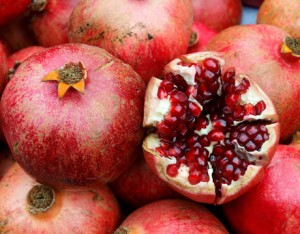 If you live in Southern California, one fruit that’s no stranger to farmer’s markets and CSA-boxes is the pomegranate.
If you live in Southern California, one fruit that’s no stranger to farmer’s markets and CSA-boxes is the pomegranate.
I only recently discovered how much I enjoy this fruit, after years of watching it be bastardized and exploited by food companies. The fruit has long been celebrated for its health benefits (it’s a good source of vitamin C and B5, potassium and polyphenols) as well as for its externel beauty (it makes a great decorative fruit, especially around the holidays) and has a deliciously rich history:
The pomegranate tree is native from Iran to the Himalayas in northern India and has been cultivated since ancient times throughout the Mediterranean region of Asia, Africa and Europe. The fruit was used in many ways as it is today and was featured in Egyptian mythology and art, praised in the Old Testament of the Bible and in the Babylonian Talmud, and it was carried by desert caravans for the sake of its thirst-quenching juice. It traveled to central and southern India from Iran about the first century A.D. and was reported growing in Indonesia in 1416. It has been widely cultivated throughout India and drier parts of southeast Asia, Malaya, the East Indies and tropical Africa. The most important growing regions are Egypt, China, Afghanistan, Pakistan, Bangladesh, Iran, Iraq, India, Burma and Saudi Arabia. There are some commercial orchards in Israel on the coastal plain and in the Jordan Valley.
Ripe and in season, typically from September/October to January/February in the Northern Hemisphere, it’s like eating sweet cranberry-flavored corn of the cob (I’ll admit this not the most elegant description but you get the point). The juicy red seed casings (what I refer to as “kernels”) are called arils and can be eaten on their own (I hear they’re great with a little salt and pepper).
Getting the arils out of the skin and inner pulp can be tricky (I’ve stained a couple white shirts with the red juice) but if you score the shell correctly and use a bowl of water (as shown below), you can save your countertops and clothing from a speckled red motif.
Happy pomegranate eating!